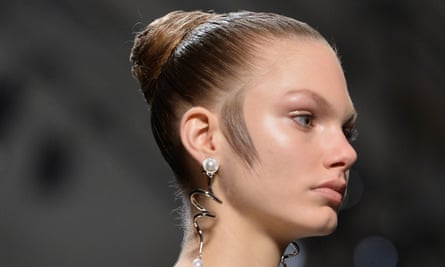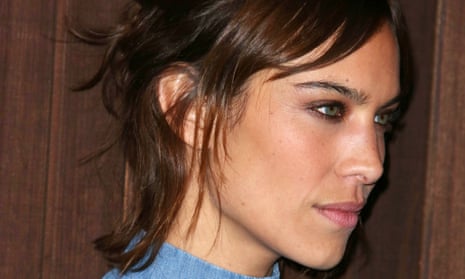A fashion trend that can count next-season Balenciaga models and Victorian women among its chief ambassadors has to be worth exploring, right? Say hello to spring’s most nuanced yet entirely uncomplicated and cost-free trend: sideburns for women.
I know. But it’s honestly happening. Back in February when Alexander Wang presented his collection for AW15, all of the models had their hair greased up into a bourgeoise bun with a distinct pair of 5cm sideburns slicked down in front of the ears. Meanwhile at Italian label Marni the models on the spring 2015 catwalk sported greasy side tendrils looped in front of the ears for an FKA twigs-meets-municipal-pool look. Despite it being a deliberate hair manoeuvre, no one stood up and pointed their finger until Leandra Medine AKA Man Repeller, US blogger, embodiment of the zeitgeist and blessed with excellent natural sideburns, suggested it could become the new sideboob. Only with less sexual, and more feminist, overtones.

Anita Bhagwandas, an expert on beauty for darker skin, is surprised by the catwalk trend, but like Medine also sees the positives in this sideburn celebration. “Traditionally women with visible sideburns – particularly those who have dark hair and paler skin like so many women of Indian and Middle Eastern descent have – have had them removed in fear of looking ‘masculine.’ But it’s empowering if it’s one less thing that women feel they should get rid of.”

George Northwood, hairdresser to fashionable clients including Alexa Chung (who herself pulls hair in front of her ears to create faux sideburns) and a man who understands the nuance of what 10 strands of artfully placed hair can project, has noticed pretend sideburns getting more traction in the high fashion in the past year or so. He says that it can be hard to pull off in real life, but that a softer version as worn by Ms Chung – more Bardot – is growing in popularity. “If you pull some strand out in front of the ear it has the opposite effect to the catwalk hair in that it softens the face.”
The haute status of the sideburn isn’t new. The look is as much National Portrait Gallery as it is Vogue. Painters such as Sir Thomas Lawrence made a career out of painting aristo women with standout sidies (Countess Grosvenor could give Man Repeller a run for her money). The Victorian women who favoured the so-called Loop hairstyle were all over the faux sideburn too – as was Barbra Streisand.

Tony Glenville, creative director of the school of media and communication at London College of Fashion, notes that when women’s sideburns in the late 60s and early 70’s were a Thing, they were cut as an integral part of the fringe and used as an aesthetic contrast – first to the Sassoon geometric cut, then later to add balance to a huge pile-up of hippy curls.
But the question is: what does it all mean? At Balenciaga the sideburn was intended to make the bun less uptight – more punk than plié. But could it be that the celebration of the sideburn on women – usually the preserve of testosteroned-up men – is evidence of redefining of what makes a woman’s face attractive? Or are we making a feature of the bits we don’t quite know what to do with in an up-do? Who knows. But haute, pragmatic, historical and possibly feminist? Bring on the sideburns.

Comments (…)
Sign in or create your Guardian account to join the discussion